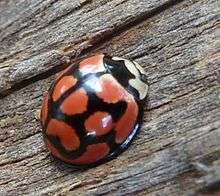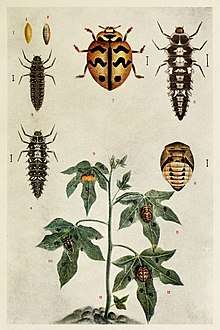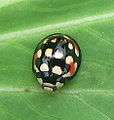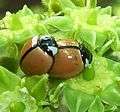Cheilomenes
Cheilomenes is a genus of ladybirds (Coccinellidae). Like other members of their subfamily they are large typical ladybirds. They are always shiny and often have bright spots on the elytra.[1] The common African species C. lunata is an important predator of the citrus aphid, Toxoptera,[1] and wheat aphid,[2] while C. vicina has been suggested as a biological control agent for the cowpea aphid.[3] Both the larvae and adults are predatory. Freshly emerged larvae consume unhatched eggs, and eventually have a dappled appearance and 6 tubercles on each abdominal segment.[2] Vulnerable stages in the life of C. sexmaculata, including oviposition, hatching, moulting and pupation have been shown to occur after dark, probably as an adaptation to avoid exposure to natural enemies.[4]
| Cheilomenes | |
|---|---|
 | |
| C. lunata in South Africa | |
| Scientific classification | |
| Kingdom: | |
| Phylum: | |
| Class: | |
| Order: | |
| Family: | |
| Subfamily: | |
| Tribe: | Coccinellini |
| Genus: | Cheilomenes Chevrolat, 1837 |
| Species | |
|
C. aurora Gerstäcker | |
Gallery
 The Six-spotted zigzag ladybird, C. sexmaculata, of Asia and Australasia
The Six-spotted zigzag ladybird, C. sexmaculata, of Asia and Australasia_mating.jpg) C. sexmaculata at Zighy Bay, Musandam Peninsula, Oman
C. sexmaculata at Zighy Bay, Musandam Peninsula, Oman C. sulfurea at Chimoio, Mozambique
C. sulfurea at Chimoio, Mozambique C. propinqua in South Africa
C. propinqua in South Africa
See also
- List of Coccinellidae genera and species
References
| Wikispecies has information related to Cheilomenes |
| Wikimedia Commons has media related to Cheilomenes. |
- Scholtz, Clarke H.; et al. (1985). Insects of Southern Africa. Durban: Butterworths. p. 251. ISBN 978-0409-10487-5.
- Picker, Mike; et al. (2004). Field Guide to Insects of South Africa. Cape Town: Struik Publishers. p. 228. ISBN 978-1-77007-061-5.
- Ofuya, T.I. (1986). "Predation by Cheilomenes vicina on the Cowpea Aphid, Aphis craccivora". Entomophaga. 31 (4): 331–335. doi:10.1007/bf02373148.
- Singh, K. (23 February 2007). "Rhythmicity in life events of an aphidophagous ladybird beetle, Cheilomenes sexmaculata". Journal of Applied Entomology. 131 (2): 85–89. doi:10.1111/j.1439-0418.2007.01148.x.